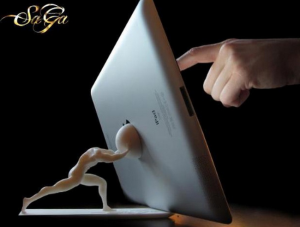In week two, we first tried to use “tinkerlad” to model something that can be printed out on 3-D printer. Our group chose a design from Austin that contains different geometric shapes and our team name “Gold Team” on it. Later we explored different website in groups. I was focus on exploring a 3-D printing design sharing website called “shapedo.com”. This website allows people to upload and share their designs online with other people. And it allows other people to download designs from the website, and make some improvements on the original design, and share the new version with other people. On this website you can find some very cool design. My favorite one is the “Gear Clock” design.
I like the “gear clock” a lot because this is a good example of how 3-D printing can be used to customize products and so to attract people. This “Gear Clock” is very artistic and unique. By 3-D printing, once you have the original digital model of it( as it is on the website), you are able to “print” the same clock out by yourself at home, and maybe add some modification of the design.
The website also categorizes different designs, which is user-friendly and allow you to find out what interests you easier.
After exploring the websites, we listened to a talk from Kylie Peppler from Indiana University. She introduced to us a lot of events/ organizations that are working on promoting or developing new technologies. For example, “Make Faire” is one event where creative makers from all over the world can gather together and share their designs to other people.
She also introduced the important idea behind DIY (Do It Yourself), which is that everyone can learn to do everything. Given the opportunities to learn and practice, people can make things come true. And she talked about some efforts on this that are focus on kids nowadays. For example, there are Make Labs all over the world, where they provide different materials to kids and encourage them to make something out of those materials. These movements were also proved to successfully encourage children to learn by making. By trying to make something out, kids are motivated to develop their knowledge and artisticity. For example, some kids who don’t have computer science background learned coding when they are doing their projects.
At last, she mentioned the socio-cultural views of construction nowadays. An artifact is not only a representation of someone himself/herself, but also can represent a social group at some extent. Also, the gender inequality in engineering field nowadays does not exist in kids who are doing the making things projects. In my opinion, this in turn can reflect that if people are motivated to do something, they can do it well, regardless of gender. Also, it reflects how the stereotype of the society may influence and discourage some female to go onto the engineering career path.
In week two’s class, we gained some information on what’s some existing projects/events/websites designated to 3-D printing technology, and we learned about some current efforts that’s been putting into motivating people to be creative and make things by themselves, integrating with the use of technologies.




























